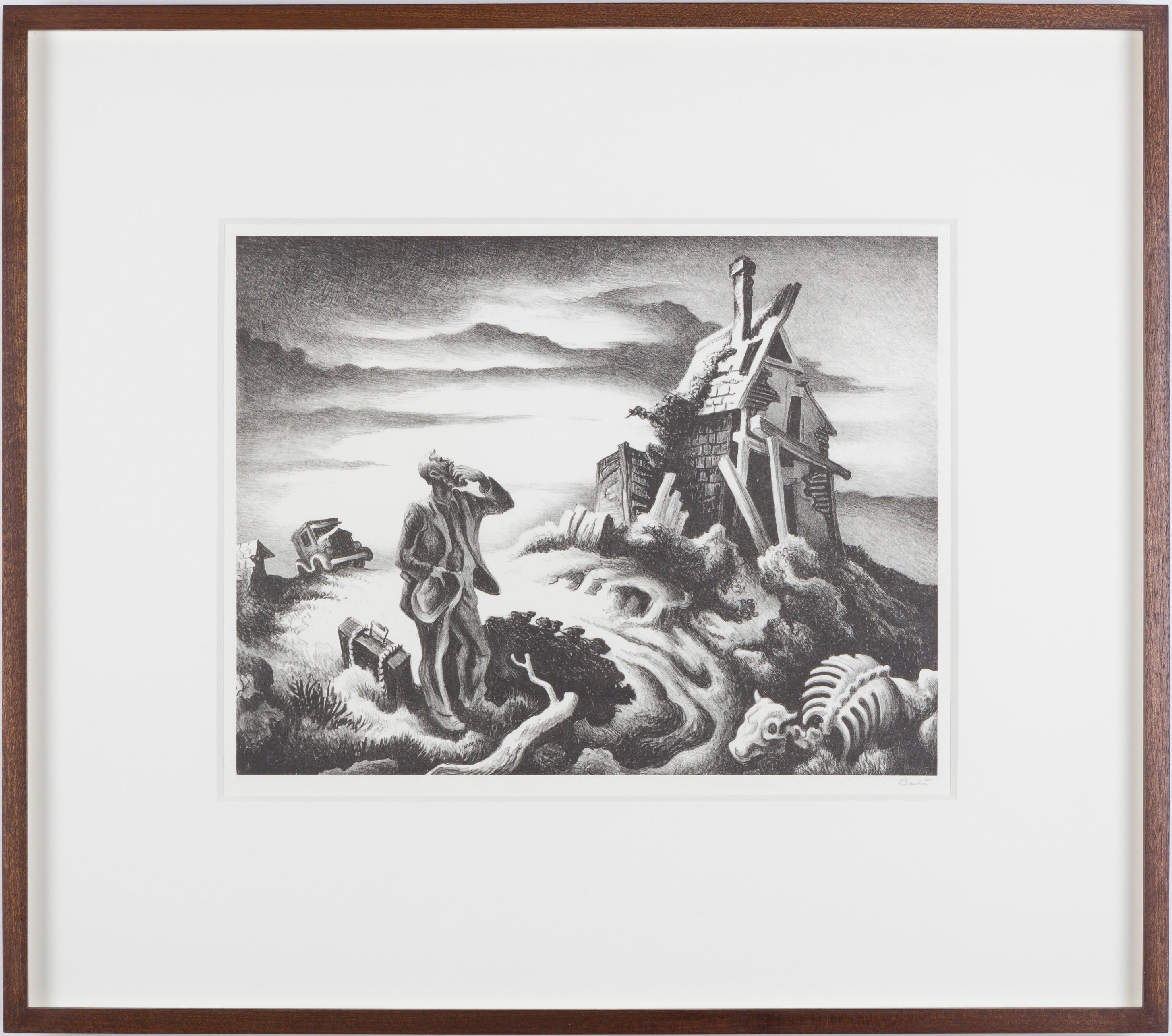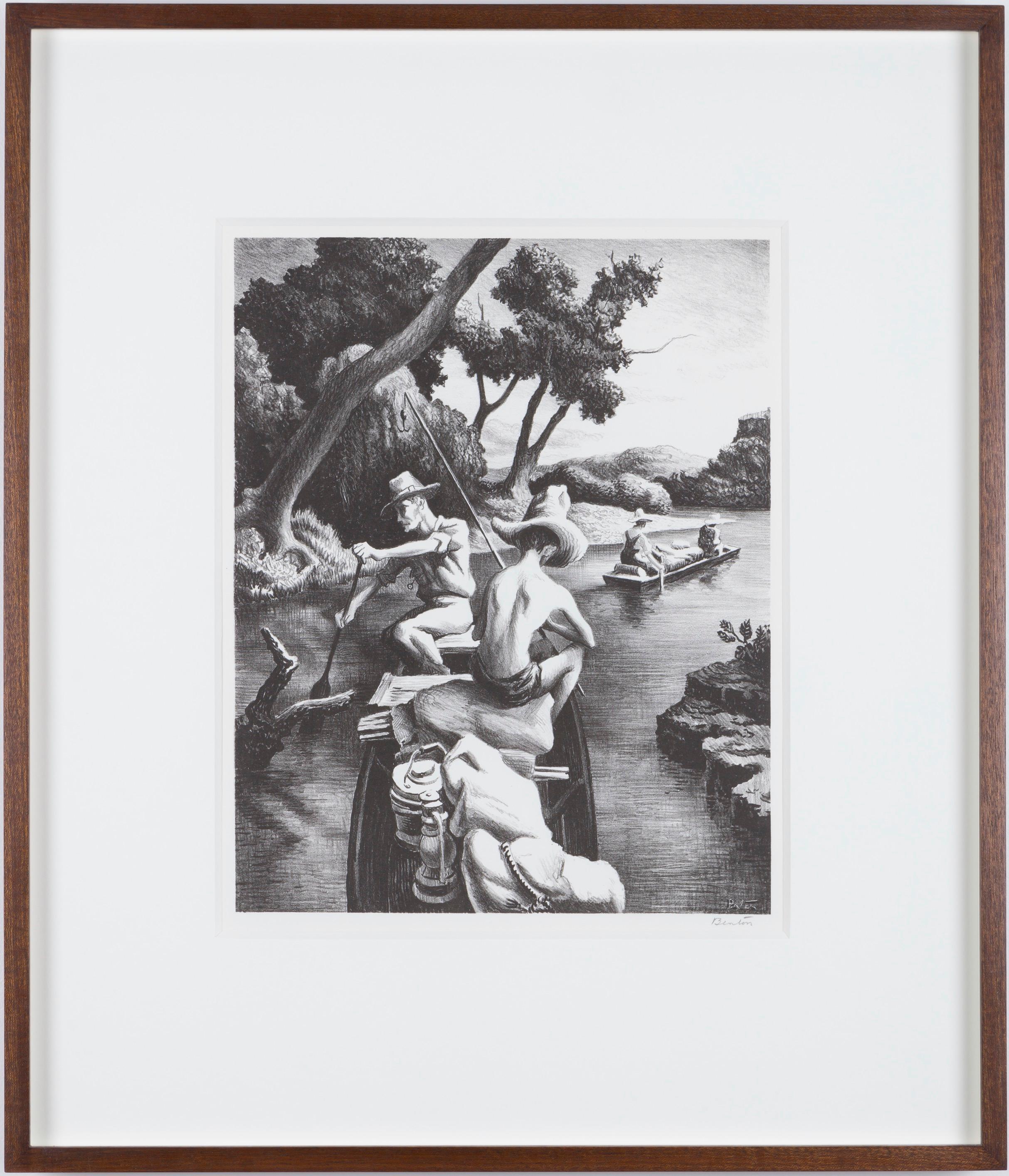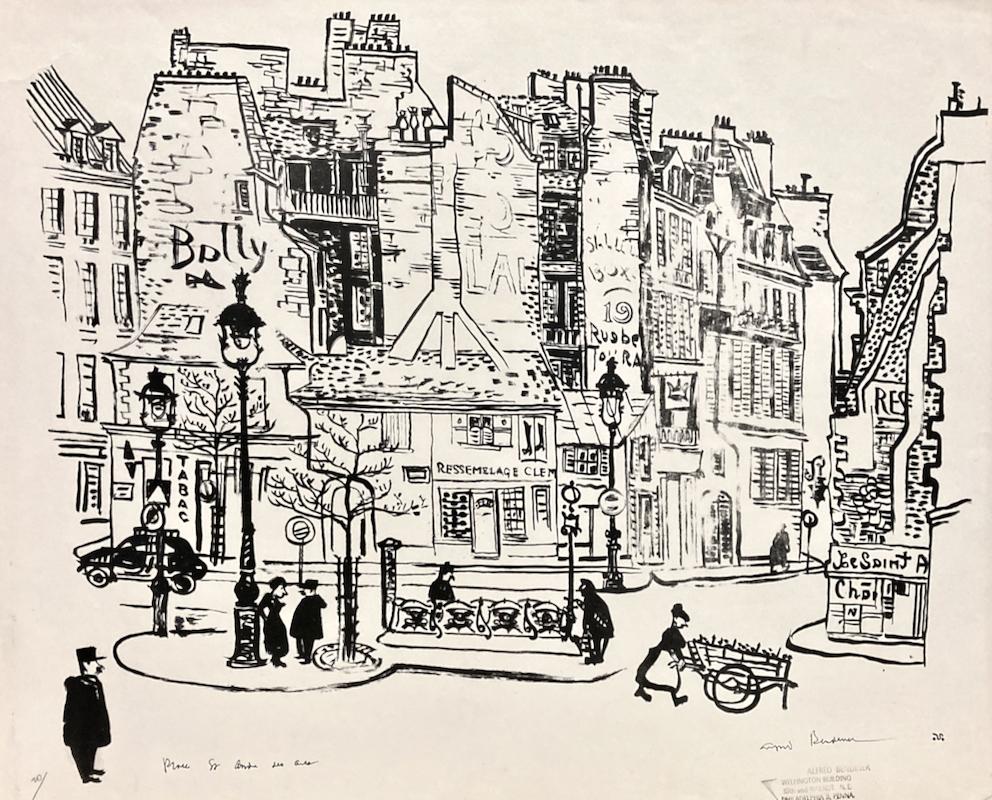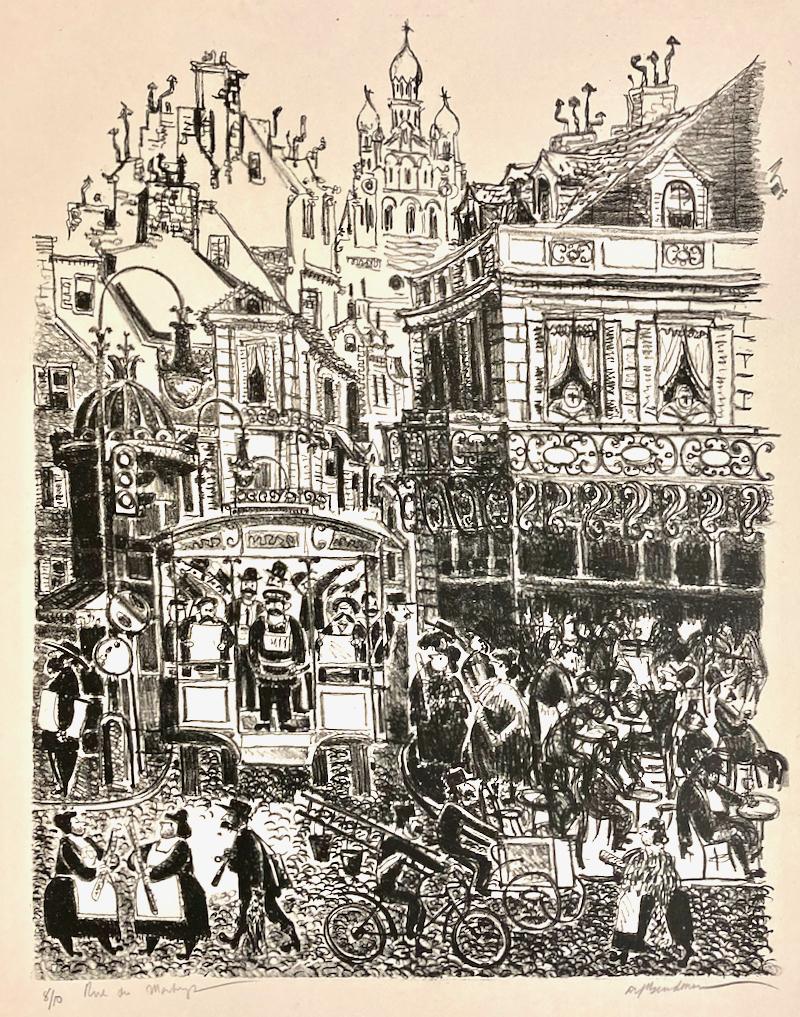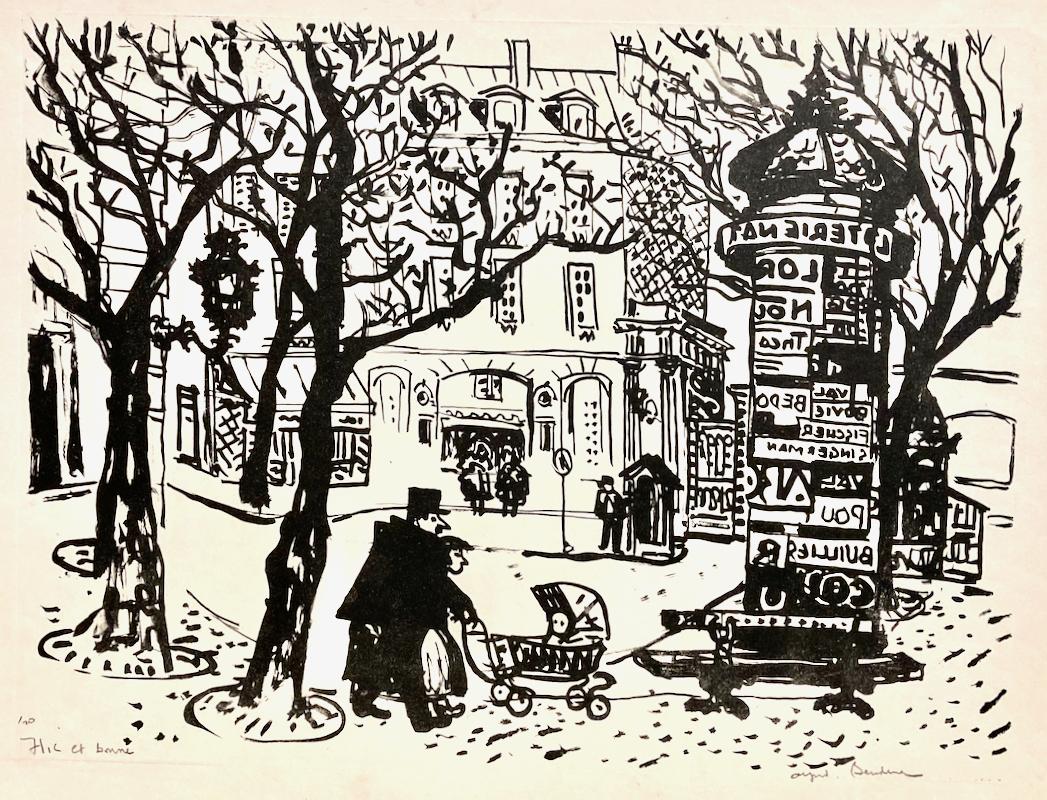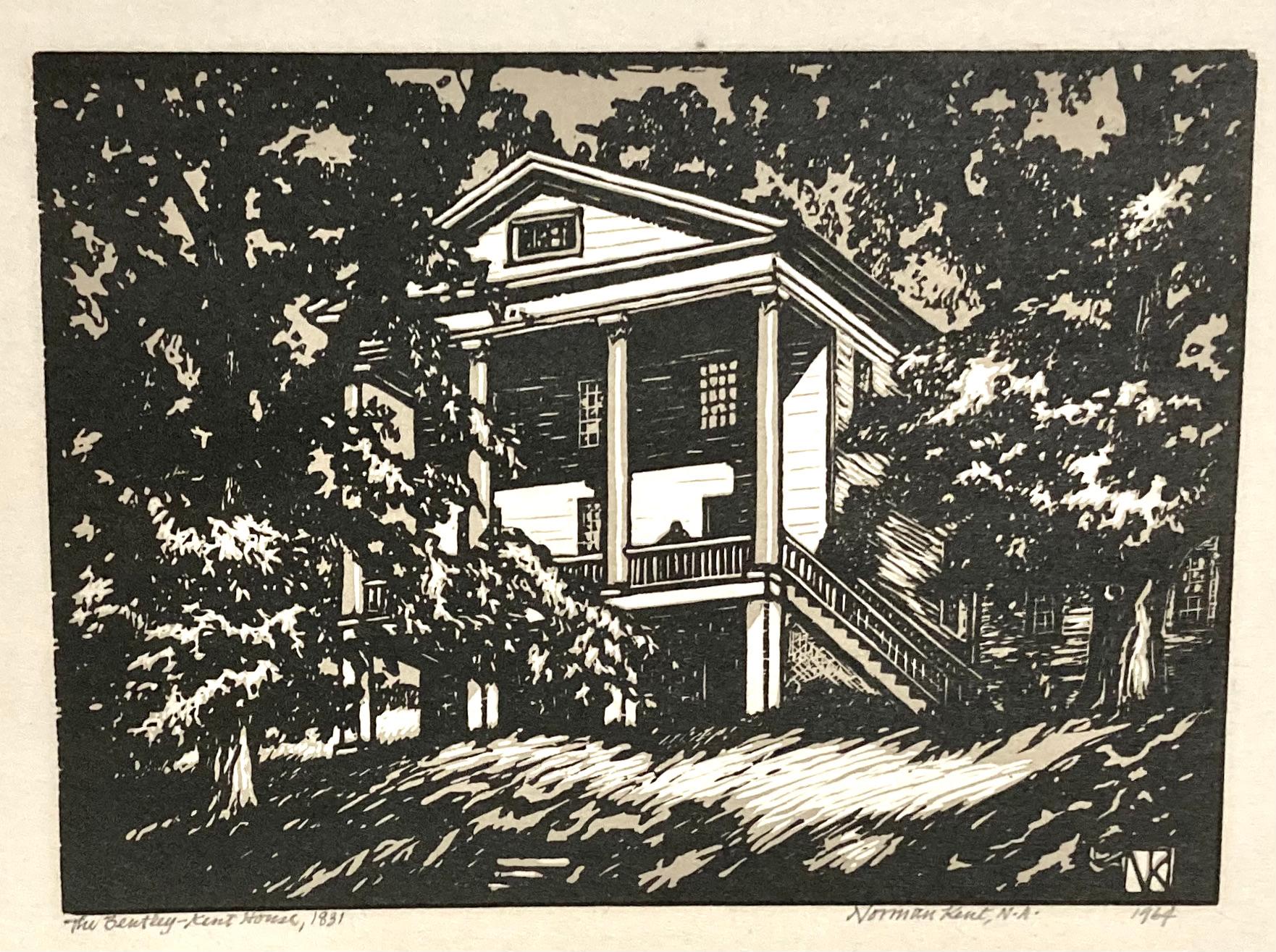Items Similar to Grand Lake, Yacht Races, Colorado Mountain Lake, 1930s Black White Print
Want more images or videos?
Request additional images or videos from the seller
1 of 7
Arnold RönnebeckGrand Lake, Yacht Races, Colorado Mountain Lake, 1930s Black White Printcirca 1932
circa 1932
About the Item
Grand Lake, Colorado, Yacht Races, vintage 1930s modernist, WPA era black and white lithograph by Colorado artist, Arnold Ronnebeck (1885-1947). Lake with sailboats with mountain landscape. Image size is 12 ¾ x 8 ½ inches (sight). Unframed, custom framing is available. Titled and dated by the artist and estate stamped on verso.
Print is clean and in very good vintage condition - please contact us for a complete condition report.
Provenance: Estate of Arnold Ronnebeck
Expedited and international shipping is available - please contact us for a quote.
- Creator:Arnold Rönnebeck (1885 - 1947)
- Creation Year:circa 1932
- Dimensions:Height: 12.75 in (32.39 cm)Width: 8.5 in (21.59 cm)Depth: 0.1 in (2.54 mm)
- Medium:
- Movement & Style:
- Period:
- Framing:Framing Options Available
- Condition:
- Gallery Location:Denver, CO
- Reference Number:
About the Seller
5.0
Platinum Seller
These expertly vetted sellers are 1stDibs' most experienced sellers and are rated highest by our customers.
Established in 1979
1stDibs seller since 2013
264 sales on 1stDibs
Typical response time: 5 hours
- ShippingRetrieving quote...Ships From: Denver, CO
- Return PolicyA return for this item may be initiated within 7 days of delivery.
More From This SellerView All
- House at Gregory Point (Colorado), 1930s Black and White Landscape LithographBy Arnold RönnebeckLocated in Denver, COOriginal Arnold Ronnebeck (1885-1947) lithograph of a home in Gregory Point, near Central City, Colorado from the 1930s. Edition of 25 printed. Presented in a custom frame, outer dimensions measure 23 ¼ x 18 ½ inches. Image size is 19 ¼ x 13 ¼ inches Print is clean and in very good vintage condition - please contact us for a detailed condition report. Provenance: Estate of Arnold Ronnebeck Expedited and international shipping is available - please contact us for a quote. About the Artist: Modernist sculptor, lithographer and museum administrator, Rönnebeck was a noted member of European and American avant-garde circles in the early twentieth century before settling in Denver, Colorado, in 1926. After studying architecture at the Royal Art School in Berlin for two years beginning in 1905, he moved to Paris in 1908 to study sculpture with Aristide Maillol and Émile-Antoine Bourdelle. While there he met and befriended American modernist painter, Marsden Hartley, of whom he sculpted a bronze head that was exhibited at the Salon d’Automne in Paris in 1912 and the following year at Hartley’s solo show of paintings at Alfred Stieglitz’s Gallery 291 in New York. A frequent guest of Gertrude Stein’s Saturday "evenings" in Paris, she described Rönnebeck as "charming and always invited to dinner," along with Pablo Picasso, Mabel Dodge (Luhan) and Charles Demuth. After the outbreak of World War I in 1914, Rönnebeck returned to Germany where he served as an officer in the German Imperial Army on the front lines. Twice wounded, including in the Battle of Marne in France, Kaiser Wilhelm II awarded him the Iron Cross. During the war Hartley fell in love with Rönnebeck’s cousin, Lieutenant Karl von Freyburg, who was killed in combat. As a tribute to Freyburg, Hartley created Portrait of a German Officer (1914) now in the Metropolitan Museum of Art in New York. After the war Rönnebeck traveled in Italy with German writer, Max Sidow, and German poet, Theodor Daubler, doing a series of drawings of Positano and the Amalfi Coast that formed the basis for his lithographs on the subject. The death of his finacée, the young American opera singer Alice Miriam in 1922 and his own family’s increasing financial problems in post-World War I Germany led him to immigrate to the United States in 1923. After living briefly with Miriam’s family in Washington, DC, he moved to New York where he became part of the avant-garde circle around Alfred Stieglitz. His essay, "Through the Eyes of a European Sculptor," appeared in the catalog for the Anderson Gallery exhibition, "Alfred Stieglitz Presents Seven Americans: 159 Paintings, Photographs & Things, Recent & Never Publicly Shown, by Arthur G. Dove, Marsden Hartley, John Marin, Charles Demuth, Paul Strand, Georgia O’Keeffe, Alfred Stieglitz." In New York Rönnebeck began producing Precisionist-style lithographs of the city’s urban landscapes which he termed "living cubism." Some of them were reproduced in Vanity Fair magazine. Through Stieglitz he met Erhard Weyhe head of the Weyhe Gallery who, with its director Carl Zigrosser, arranged Rönnebeck’s first solo American exhibition in May 1925 at the gallery in New York. Comprising some sixty works – prints, drawings and sculpture – the show subsequently traveled on a thirteen-month tour of major American cities. Until the end of his life, the gallery represented him, along with other American artists Adolf Dehn, Wanda Gag, Rockwell Kent, J.J. Lankes, Louis Lozowick, Reginald Marsh and John Sloan. In the summer of 1925, as the guest of Mabel Dodge Luhan, Rönnebeck first saw Taos, New Mexico, which Marsden Hartley had encouraged him to visit. It was there that he met his future wife, Louise Emerson, an easel painter and muralist. A year later they were married in New York before relocating to Denver. He served as director of the Denver Art Museum from 1926 to 1930 where he invited Marsden Hartley to lecture on Cézanne’s art in 1928. Rönnebeck fostered the development of the museum’s collection of American Indian art and the curation of modernist art exhibitions. In addition to his work at the museum, he was professor of sculpture at the University of Denver’s College of Fine and Applied Arts from 1929 to 1935, and wrote a weekly art column in the Rocky Mountain News. His best known Denver sculptures from the late 1920s in bronze, copper, stone, wood and terra cotta include a reredos, The Epiphany, at St. Martin’s Chapel; The History of Money (six panels) at the Denver National Bank; The Ascension at the Church of Ascension; and the William V. Hodges Family Memorial at Fairmount Cemetery. At the same time he did a series of terra cotta relief panels for La Fonda Hotel in Santa Fe, New Mexico. In the 1930s his bas-relief aluminum friezes of stylized Pueblo and Hopi Indian Kachina masks...Category
1930s American Modern Landscape Prints
MaterialsPaper, Lithograph
- Silver Mine, Russell Gulch (12/25) Abstract Black and White Print in MountainsBy Arnold RönnebeckLocated in Denver, COLithograph on paper titled 'Silver Mine, Russell Gulch (12/25)' by Arnold Ronnebeck, which is a black and white lithograph print of an oil painting by him of the same name. It shows a mine with a mountain ridge in the background. Presented in a custom frame measuring 20 ½ x 26 ½ inches. Image size measures 10 ¼ x 14 ¼ inches. Print is clean and in very good vintage condition - please contact us for a detailed condition report. Provenance: Estate of Arnold Ronnebeck Expedited and international shipping is available - please contact us for a quote. About the Artist: Modernist sculptor, lithographer and museum administrator, Rönnebeck was a noted member of European and American avant-garde circles in the early twentieth century before settling in Denver, Colorado, in 1926. After studying architecture at the Royal Art School in Berlin for two years beginning in 1905, he moved to Paris in 1908 to study sculpture with Aristide Maillol and Émile-Antoine Bourdelle. While there he met and befriended American modernist painter, Marsden Hartley, of whom he sculpted a bronze head that was exhibited at the Salon d’Automne in Paris in 1912 and the following year at Hartley’s solo show of paintings at Alfred Stieglitz’s Gallery 291 in New York. A frequent guest of Gertrude Stein’s Saturday "evenings" in Paris, she described Rönnebeck as "charming and always invited to dinner," along with Pablo Picasso, Mabel Dodge (Luhan) and Charles Demuth. After the outbreak of World War I in 1914, Rönnebeck returned to Germany where he served as an officer in the German Imperial Army on the front lines. Twice wounded, including in the Battle of Marne in France, Kaiser Wilhelm II awarded him the Iron Cross. During the war Hartley fell in love with Rönnebeck’s cousin, Lieutenant Karl von Freyburg, who was killed in combat. As a tribute to Freyburg, Hartley created Portrait of a German Officer (1914) now in the Metropolitan Museum of Art in New York. After the war Rönnebeck traveled in Italy with German writer, Max Sidow, and German poet, Theodor Daubler, doing a series of drawings of Positano and the Amalfi Coast that formed the basis for his lithographs on the subject. The death of his finacée, the young American opera singer Alice Miriam in 1922 and his own family’s increasing financial problems in post-World War I Germany led him to immigrate to the United States in 1923. After living briefly with Miriam’s family in Washington, DC, he moved to New York where he became part of the avant-garde circle around Alfred Stieglitz. His essay, "Through the Eyes of a European Sculptor," appeared in the catalog for the Anderson Gallery exhibition, "Alfred Stieglitz Presents Seven Americans: 159 Paintings, Photographs & Things, Recent & Never Publicly Shown, by Arthur G. Dove, Marsden Hartley, John Marin, Charles Demuth, Paul Strand, Georgia O’Keeffe, Alfred Stieglitz." In New York Rönnebeck began producing Precisionist-style lithographs of the city’s urban landscapes which he termed "living cubism." Some of them were reproduced in Vanity Fair magazine. Through Stieglitz he met Erhard Weyhe head of the Weyhe Gallery who, with its director Carl Zigrosser, arranged Rönnebeck’s first solo American exhibition in May 1925 at the gallery in New York. Comprising some sixty works – prints, drawings and sculpture – the show subsequently traveled on a thirteen-month tour of major American cities. Until the end of his life, the gallery represented him, along with other American artists Adolf Dehn, Wanda Gag, Rockwell Kent, J.J. Lankes, Louis Lozowick, Reginald Marsh and John Sloan. In the summer of 1925, as the guest of Mabel Dodge Luhan, Rönnebeck first saw Taos, New Mexico, which Marsden Hartley had encouraged him to visit. It was there that he met his future wife, Louise Emerson, an easel painter and muralist. A year later they were married in New York before relocating to Denver. He served as director of the Denver Art Museum from 1926 to 1930 where he invited Marsden Hartley to lecture on Cézanne’s art in 1928. Rönnebeck fostered the development of the museum’s collection of American Indian art and the curation of modernist art exhibitions. In addition to his work at the museum, he was professor of sculpture at the University of Denver’s College of Fine and Applied Arts from 1929 to 1935, and wrote a weekly art column in the Rocky Mountain News. His best known Denver sculptures from the late 1920s in bronze, copper, stone, wood and terra cotta include a reredos, The Epiphany, at St. Martin’s Chapel; The History of Money (six panels) at the Denver National Bank; The Ascension at the Church of Ascension; and the William V. Hodges Family Memorial at Fairmount Cemetery. At the same time he did a series of terra cotta relief panels for La Fonda Hotel in Santa Fe, New Mexico. In the 1930s his bas-relief aluminum friezes of stylized Pueblo and Hopi Indian Kachina masks...Category
1930s American Modern Figurative Prints
MaterialsPaper, Lithograph
- Mine Near Continental Divide, Black White Colorado Mountain Landscape WinterBy Arnold RönnebeckLocated in Denver, COLithograph on paper titled 'Mine Near Continental Divide' by Arnold Ronnebeck (1885-1947) from 1933. Depicts a black and white winter scene of a mine in the mountains with snow on the rooftops and hillsides. Presented in a custom frame measuring 18 ¼ x 22 ¼ inches. Image size measures 10 ¼ x 14 ½ inches. Provenance: Estate of the Artist, Arnold Ronnebeck Expedited and international shipping is available - please contact us for a quote. About the Artist: Modernist sculptor, lithographer and museum administrator, Rönnebeck was a noted member of European and American avant-garde circles in the early twentieth century before settling in Denver, Colorado, in 1926. After studying architecture at the Royal Art School in Berlin for two years beginning in 1905, he moved to Paris in 1908 to study sculpture with Aristide Maillol and Émile-Antoine Bourdelle. While there he met and befriended American modernist painter, Marsden Hartley, of whom he sculpted a bronze head that was exhibited at the Salon d’Automne in Paris in 1912 and the following year at Hartley’s solo show of paintings at Alfred Stieglitz’s Gallery 291 in New York. A frequent guest of Gertrude Stein’s Saturday "evenings" in Paris, she described Rönnebeck as "charming and always invited to dinner," along with Pablo Picasso, Mabel Dodge (Luhan) and Charles Demuth. After the outbreak of World War I in 1914, Rönnebeck returned to Germany where he served as an officer in the German Imperial Army on the front lines. Twice wounded, including in the Battle of Marne in France, Kaiser Wilhelm II awarded him the Iron Cross. During the war Hartley fell in love with Rönnebeck’s cousin, Lieutenant Karl von Freyburg, who was killed in combat. As a tribute to Freyburg, Hartley created Portrait of a German Officer (1914) now in the Metropolitan Museum of Art in New York. After the war Rönnebeck traveled in Italy with German writer, Max Sidow, and German poet, Theodor Daubler, doing a series of drawings of Positano and the Amalfi Coast that formed the basis for his lithographs on the subject. The death of his finacée, the young American opera singer Alice Miriam in 1922 and his own family’s increasing financial problems in post-World War I Germany led him to immigrate to the United States in 1923. After living briefly with Miriam’s family in Washington, DC, he moved to New York where he became part of the avant-garde circle around Alfred Stieglitz. His essay, "Through the Eyes of a European Sculptor," appeared in the catalog for the Anderson Gallery exhibition, "Alfred Stieglitz Presents Seven Americans: 159 Paintings, Photographs & Things, Recent & Never Publicly Shown, by Arthur G. Dove, Marsden Hartley, John Marin, Charles Demuth, Paul Strand, Georgia O’Keeffe, Alfred Stieglitz." In New York Rönnebeck began producing Precisionist-style lithographs of the city’s urban landscapes which he termed "living cubism." Some of them were reproduced in Vanity Fair magazine. Through Stieglitz he met Erhard Weyhe head of the Weyhe Gallery who, with its director Carl Zigrosser, arranged Rönnebeck’s first solo American exhibition in May 1925 at the gallery in New York. Comprising some sixty works – prints, drawings and sculpture – the show subsequently traveled on a thirteen-month tour of major American cities. Until the end of his life, the gallery represented him, along with other American artists Adolf Dehn, Wanda Gag, Rockwell Kent, J.J. Lankes, Louis Lozowick, Reginald Marsh and John Sloan. In the summer of 1925, as the guest of Mabel Dodge Luhan, Rönnebeck first saw Taos, New Mexico, which Marsden Hartley had encouraged him to visit. It was there that he met his future wife, Louise Emerson, an easel painter and muralist. A year later they were married in New York before relocating to Denver. He served as director of the Denver Art Museum from 1926 to 1930 where he invited Marsden Hartley to lecture on Cézanne’s art in 1928. Rönnebeck fostered the development of the museum’s collection of American Indian art and the curation of modernist art exhibitions. In addition to his work at the museum, he was professor of sculpture at the University of Denver’s College of Fine and Applied Arts from 1929 to 1935, and wrote a weekly art column in the Rocky Mountain News. His best known Denver sculptures from the late 1920s in bronze, copper, stone, wood and terra cotta include a reredos, The Epiphany, at St. Martin’s Chapel; The History of Money (six panels) at the Denver National Bank; The Ascension at the Church of Ascension; and the William V. Hodges Family Memorial at Fairmount Cemetery. At the same time he did a series of terra cotta relief panels for La Fonda Hotel in Santa Fe, New Mexico. In the 1930s his bas-relief aluminum friezes of stylized Pueblo and Hopi Indian Kachina masks...Category
1930s American Modern Landscape Prints
MaterialsLithograph, Paper
- Gem Mining Company, Colorado Landscape Mining Scene 1930s Lithograph PrintBy Arnold RönnebeckLocated in Denver, CO'Gem Mining Company', lithograph by Arnold Ronnebeck from 1932. Colorado mining scene with several mining buildings amongst the mountains. Presented in...Category
1930s American Modern Landscape Prints
MaterialsLithograph
- Colorado Gold Dredge, Breckenridge, Signed Black and White Mining LithographBy Arnold RönnebeckLocated in Denver, COLithograph on paper titled 'Colorado Gold Dredge, Breckenridge' by Arnold Ronnebeck (1885-1947) from 1932. Numbered 15/25. Depicted is a gold dredge in Colorado mining town Breckenridge with a mountain landscape in the background. Presented in a custom frame measuring 17 ¼ x 21 ¼ inches. Image size measures 10 ¼ x 14 ¼ inches. Print is clean and in very good vintage condition - please contact us for a detailed condition report. Provenance: Estate of Arnold Ronnebeck Expedited and international shipping is available - please contact us for a quote. About the Artist: Modernist sculptor, lithographer and museum administrator, Rönnebeck was a noted member of European and American avant-garde circles in the early twentieth century before settling in Denver, Colorado, in 1926. After studying architecture at the Royal Art School in Berlin for two years beginning in 1905, he moved to Paris in 1908 to study sculpture with Aristide Maillol and Émile-Antoine Bourdelle. While there he met and befriended American modernist painter, Marsden Hartley, of whom he sculpted a bronze head that was exhibited at the Salon d’Automne in Paris in 1912 and the following year at Hartley’s solo show of paintings at Alfred Stieglitz’s Gallery 291 in New York. A frequent guest of Gertrude Stein’s Saturday "evenings" in Paris, she described Rönnebeck as "charming and always invited to dinner," along with Pablo Picasso, Mabel Dodge (Luhan) and Charles Demuth. After the outbreak of World War I in 1914, Rönnebeck returned to Germany where he served as an officer in the German Imperial Army on the front lines. Twice wounded, including in the Battle of Marne in France, Kaiser Wilhelm II awarded him the Iron Cross. During the war Hartley fell in love with Rönnebeck’s cousin, Lieutenant Karl von Freyburg, who was killed in combat. As a tribute to Freyburg, Hartley created Portrait of a German Officer (1914) now in the Metropolitan Museum of Art in New York. After the war Rönnebeck traveled in Italy with German writer, Max Sidow, and German poet, Theodor Daubler, doing a series of drawings of Positano and the Amalfi Coast that formed the basis for his lithographs on the subject. The death of his finacée, the young American opera singer Alice Miriam in 1922 and his own family’s increasing financial problems in post-World War I Germany led him to immigrate to the United States in 1923. After living briefly with Miriam’s family in Washington, DC, he moved to New York where he became part of the avant-garde circle around Alfred Stieglitz. His essay, "Through the Eyes of a European Sculptor," appeared in the catalog for the Anderson Gallery exhibition, "Alfred Stieglitz Presents Seven Americans: 159 Paintings, Photographs & Things, Recent & Never Publicly Shown, by Arthur G. Dove, Marsden Hartley, John Marin, Charles Demuth, Paul Strand, Georgia O’Keeffe, Alfred Stieglitz." In New York Rönnebeck began producing Precisionist-style lithographs of the city’s urban landscapes which he termed "living cubism." Some of them were reproduced in Vanity Fair magazine. Through Stieglitz he met Erhard Weyhe head of the Weyhe Gallery who, with its director Carl Zigrosser, arranged Rönnebeck’s first solo American exhibition in May 1925 at the gallery in New York. Comprising some sixty works – prints, drawings and sculpture – the show subsequently traveled on a thirteen-month tour of major American cities. Until the end of his life, the gallery represented him, along with other American artists Adolf Dehn, Wanda Gag, Rockwell Kent, J.J. Lankes, Louis Lozowick, Reginald Marsh and John Sloan. In the summer of 1925, as the guest of Mabel Dodge Luhan, Rönnebeck first saw Taos, New Mexico, which Marsden Hartley had encouraged him to visit. It was there that he met his future wife, Louise Emerson, an easel painter and muralist. A year later they were married in New York before relocating to Denver. He served as director of the Denver Art Museum from 1926 to 1930 where he invited Marsden Hartley to lecture on Cézanne’s art in 1928. Rönnebeck fostered the development of the museum’s collection of American Indian art and the curation of modernist art exhibitions. In addition to his work at the museum, he was professor of sculpture at the University of Denver’s College of Fine and Applied Arts from 1929 to 1935, and wrote a weekly art column in the Rocky Mountain News. His best known Denver sculptures from the late 1920s in bronze, copper, stone, wood and terra cotta include a reredos, The Epiphany, at St. Martin’s Chapel; The History of Money (six panels) at the Denver National Bank; The Ascension at the Church of Ascension; and the William V. Hodges Family Memorial at Fairmount Cemetery. At the same time he did a series of terra cotta relief panels for La Fonda Hotel in Santa Fe, New Mexico. In the 1930s his bas-relief aluminum friezes of stylized Pueblo and Hopi Indian Kachina masks...Category
1930s American Modern Landscape Prints
MaterialsPaper, Lithograph
- 'Mining Town' , American Modern Signed Lithograph, Colorado Mining Town SceneBy Robert BeauchampLocated in Denver, COAmerican modern lithograph on paper titled 'Mining Town' signed by artist Robert Beauchamp (1923-1995) featuring a figure walking and a cat sitting on a fence in a mining town. Image...Category
Mid-20th Century American Modern Landscape Prints
MaterialsPaper, Lithograph
You May Also Like
- Prodigal SonBy Thomas Hart BentonLocated in London, GBA fine impression with full margins published by Associated American Artists with their information label present - pictured in Art and Popular Religion in Evangelical America, 1815-...Category
1930s American Modern Landscape Prints
MaterialsLithograph
- Down the RiverBy Thomas Hart BentonLocated in London, GBA fine impression of this popular Benton image with good margins.Category
1930s American Modern Figurative Prints
MaterialsLithograph
- Alfred Bendiner, Place St. Andre des Arts (Paris)By Alfred BendinerLocated in New York, NYThe Place St. Andre des Arts, on the Left Bank in Paris, would have been a natural environment for Bendiner. It was the Latin Quarter, just south of the Louvre and near everything im...Category
1950s American Modern Landscape Prints
MaterialsLithograph
- Alfred Bendiner, Rue des Matrys (Paris)By Alfred BendinerLocated in New York, NYWorld traveler that he was, Bendiner was clearly at home in Paris. He found everyone fascinating and has made this print a compendium of local characters and types. Nothing escapes h...Category
1950s American Modern Landscape Prints
MaterialsLithograph
- Alfred Bendiner, Flic et Bonne (Gendarme and Nursemaid)By Alfred BendinerLocated in New York, NYThe world was Bendiner's oyster, but here he shows us a all we need in a small corner of Paris. It's charming and safe: the 'Flic et Bonne' (gendarme and nursemaid) are together, goi...Category
1950s American Modern Landscape Prints
MaterialsLithograph
- Norman Kent, The Bentley-Kent House, 1831Located in New York, NYSigned titled, and dated, in pencil, and annotated in lower margin "My great-great grandfather's house, built in Bentleyville, Ohio in 1831; torn down in 1956." The wood engraving i...Category
1960s American Modern Landscape Prints
MaterialsLithograph
